I’ve long thought that the genres of science fiction and horror are especially well suited to the short story format. I’ve previously written a piece collecting a few of my favorite sci-fi flash fiction pieces, all of which demonstrate that a great sci-fi story doesn’t necessarily require a lot of words. Along with my fondness for quick and punchy stories that can stand entirely on their own, I also tend to love an interlinked short story collection, with each tale building on the last in order to tell a larger story.
This format has worked a treat for titans of the sci-fi genre—we need look no further than Isaac Asimov’s I, Robot and Ray Bradbury’s The Martian Chronicles, both fix-up collections published in 1950 that have achieved classic status. Below I’ve gathered some more modern examples, including some of my favorite collections of connected short stories for fans of science fiction and horror, with a little bit of fantasy thrown in for good measure.
Parasite (2016) by Darcy Coates
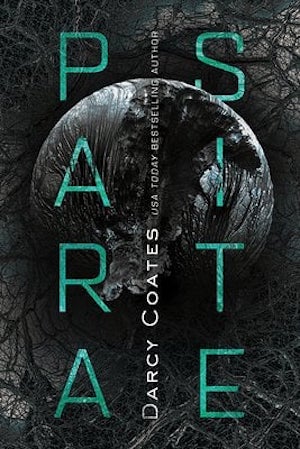
John Carpenter’s The Thing (1982), an adaptation of John W. Campbell’s “Who Goes There?” (1938), leaves viewers grappling with the possibility that the alien creature hasn’t been destroyed and will soon escape Antarctica and assimilate, well, everybody on Earth. In Parasite, Darcy Coates takes all the fear and dread inherent in that possibility and turns it into terrifying reality, charting the lethal spread of a parasitic alien across the universe.
The first story in Parasite is set in a small outpost on a remote moon. One of the workers comes across an unidentified life form—essentially a black blob with tendrils—that doesn’t seem threatening so she decides to poke it (which is always a mistake). The creature attacks and takes up residence within her body, making its subsequent attacks on her colleagues all the easier.
The very idea of being turned into a meat puppet by a gooey alien is horrific enough, but each story in Parasite ramps up the horror by showing humanity’s situation becoming progressively worse as the creature topples space stations like dominoes. It’s a fast-paced, tense, and terrifying slice of sci-fi horror.
How High We Go in the Dark (2022) by Sequoia Nagamatsu
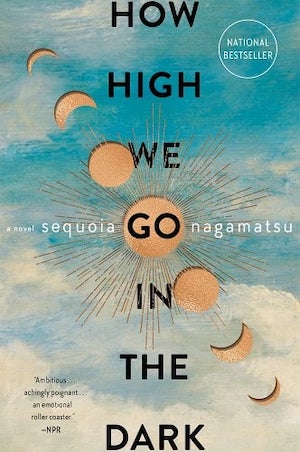
Post-apocalyptic books often tread a dark path, but there are some that find hope at the end of the world and Sequoia Nagamatsu’s How High We Go in the Dark is definitely one of those. Chronicling humanity’s various attempts to move forward after the outbreak of a brutal virus, Nagamatsu’s interconnected collection isn’t without sadness—there’s an elegy hotel for the many deceased and a euthanasia rollercoaster—but each story looks for the light within the darkness.
The stories demonstrate that even when faced with a world-changing, likely world-ending, catastrophe, there is always hope. Not only are there tales of various visionaries attempting to find a practical solution to save humankind, but all of the stories show love enduring in all of its forms—romantic, platonic, and familial.
Lovecraft Country (2016) by Matt Ruff
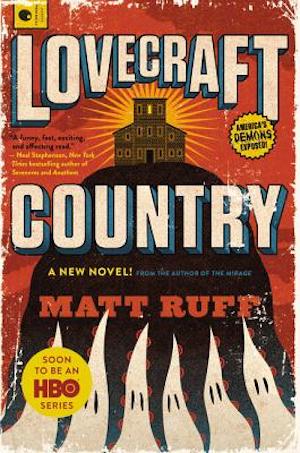
Set during the 1950s, Lovecraft Country tells eight loosely connected stories about Black veteran Atticus Turner and his friends and family. Thanks to a secret coven of White sorcerers, led by Samuel Braithwhite, the group are sometimes drawn, sometimes dragged, into various horrific and fantastical situations.
Matt Ruff jumps effortlessly between genres in the collection. One chapter is a classic haunted house story, while the next is a magic-infused pulpy adventure. And along with the Lovecraftian monsters and threatening ghosts, Atticus and company also have to contend with the very real horrors of racism in Jim Crow-era America. Each story in Lovecraft Country manages to have its own distinct flavor, while also contributing to the horrifying banquet that is the larger overall story.
Semiosis (2018) by Sue Burke
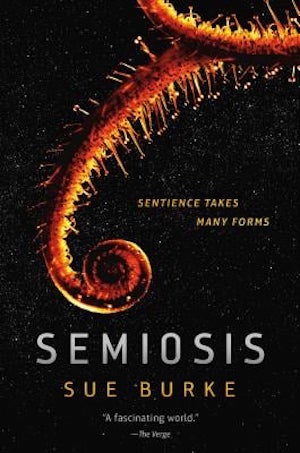
The first in a trilogy of novels (the third of which isn’t scheduled for release until 2024), Semiosis charts humanity’s attempt to colonize another planet after fleeing a war-torn and ecologically-ravaged Earth. The group of colonists come across a suitable planet that they name Pax, but settling on this new world involves a steep learning curve, not least because it’s dominated by a sentient plant.
Each chapter skips forward a little in time, following the development of each successive generation as they try to integrate themselves into Pax’s complex ecosystem. Along with figuring out how to coexist with the flora and fauna, the settlers also struggle with the human tensions and issues that crop up within any large group of people (which necessitates a content warning for violence and a brief depiction of sexual assault). Intrigued? Handily, Tor.com has an excerpt from the start of the novel, if you’d like to check it out!
I’m Waiting for You: And Other Stories (2021) by Kim Bo-Young (translated by Sophie Bowman and Sung Ryu)
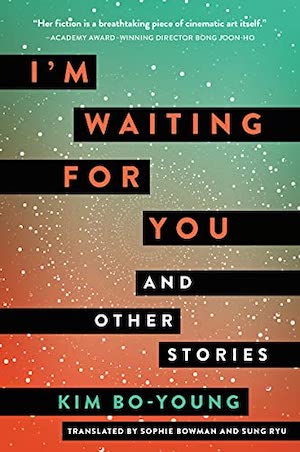
The four stories in Kim Bo-Young’s I’m Waiting for You: And Other Stories are split into two completely different tales. The first and fourth stories are a romantic, but tragic, love story told in epistolary format. Sandwiched between these two stories is a philosophical mediation on free will and morality from the POV of godlike creatures.
“I’m Waiting for You” is told through letters a groom-to-be is writing to his fiancée, who is on an intergalactic mission. Relativity means that the journey will take just months for her, but he will be waiting for years on Earth. Desperate to get to their wedding day, he decides to take a quick lightspeed trip through space, but things don’t go exactly as planned. In “On My Way” we read the bride-to-be’s letters, which reveal that her journey doesn’t go smoothly either.
Stories two and three, “The Prophet of Corruption” and “That One Life,” are far more challenging and I recommend reading the glossary to get a basic understanding of the world before diving in. Earth is essentially a playground for our creator characters. One of these beings begins to question how things are done, which leads to an examination of identity and ethics. It’s surreal and complicated, but well worth wrapping your head around.
***
As always, this list isn’t meant to be exhaustive, so please share your thoughts and recommend your own favorite collections of interlinked SFF short stories in the comments below!
Lorna Wallace has a PhD in English Literature and is a lover of all things science fiction and horror. She lives in Scotland with her rescue greyhound, Misty.










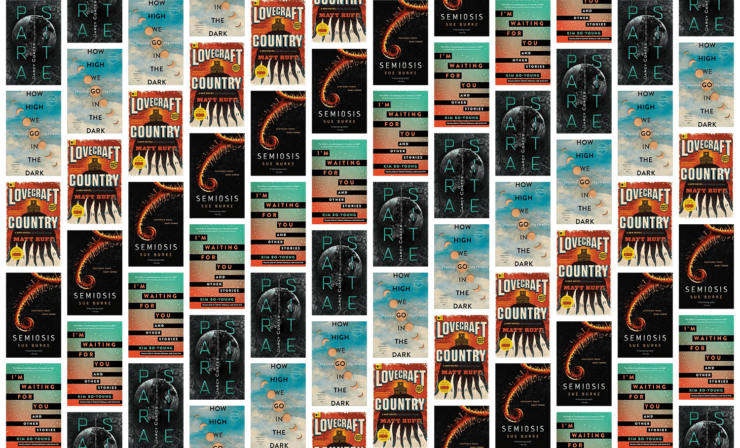
Murderbot!
See also Back in the USSA (1997) by Eugene Byrne and Kim Newman. A collection of seven stories depicting an alternate-history where the United States underwent a Bolshevik-style revolution in 1917 under the leadership of Eugene Debs, following through the equivalents of Stalin’s rule (Al Capone), the Krushschev thaw (under Barry Goldwater), to a “glasnost” period under Kurt Vonnegut (as Gorbachev), to an eventual breakup. There is a mixture of both historical and fictional characters throughout (e.g., the overthrown President in 1917 is Charles Foster Kane).
Not sure if “gripping” can be applied, but John Scalzi’s The Human Division comes to mind here.
“Cloud Atlas,” by David Mitchell.
I thought Cloud Atlas read like a group of unrelated short stories, but loved the film. For me, it was much more successful in living up to the theme that ‘everything is connected’.
I recommend the 1992 book “Murasaki”, six short stories in a “shared world” theme that features some heavy hitters- David Brin, Poul Anderson, Greg Bear, Gregory Benford, Nancy Kress and Frederick Pohl. Some of the stories evoke a haunting Bradbury Martian Chronicles theme. Great work.
https://en.m.wikipedia.org/wiki/Murasaki_(novel)
I very much liked Semiosis, glad to see it getting some love. In a similar (structural) vein, Lavie Tidhar’s Central Station would fit right in alongside this list.
The first two Witcher books are interlocked stories over various periods of time.
If we squint, Bujold’s Borders of Insanity could fit into this category, with its three novellas in the Vorkosigan-verse.
Aaronovitch’s Tales from the Folly could do so as well.
KM Herkes’ book Rough Passages is some great linked stories!
Super-powered grandmothers, elemental Marines, and extraordinary teens: A world where every midlife crisis might become a national emergency.
Ever since one disastrous night during World War 2, a third of the world’s population has carried the potential to “roll into power.” No one can predict which few will actually go through the change, and there’s only one, tragic certainty: rolling before the age of forty is a death sentence.
Passing into middle age might be uneventful, marked only by extra candles on your birthday cake, but it might lead to becoming a human fireball, drowning a city, or teleporting into outer space. Rough Passages is the stories of five people forever changed and connected by the powers that disrupt their lives:
1. A single mother with two jobs whose new talent changes her life beyond her wildest dreams.
2. A Marine captain tasked with investigating the all-too-human crimes a squad of super-powered soldiers can commit.
3. A lonely woman whose desperate homesickness is matched in strength only by her ability to wreak seismic havoc.
4. A grandmother, torn from home and family, abused and imprisoned, who must choose between revenge and forgiveness.
5. A teenager afraid to take the R-factor test that will define her future, who learns there are worse things to fear than a positive result.
Forgot about the Wild Cards universe, edited by GRRM. Isn’t that the best illustration of this concept?
Though Walter M Miller’s classic “A Canticle for Liebowitz” is considered a novel, it consists of three interlinked novellas, which were originally published separately. However you categorise it, it’s a magnificent book.
The first example that popped into my head was The Fifth Head of Cerberus by Gene Wolfe. Three short related tales, in no obvious order, that each can be interpreted multiple ways. This was what hooked me on Gene Wolfe for life.
There’s a number of such fix-ups which have remained perennial favorites of mine. I like the format because a.) first, the author has to have established at least a small body of work and b) has to have had the skill to unite thematically-disparate stories into a reasonable coherent whole. An additional payoff is that often the bridging vignettes between stories are often as interesting as the stories themselves. Here are three collections which exemplify this:
— City, by Clifford Simak. Humans get into their spaceships and go away somewhere, leaving planet Earth to their dogs and robots. Well, dogs are loyal and playful, and robots reliable. The resulting melange is typical Simak, by turns amusing, thoughtful, elegiac, and imbued with Simak’s characteristic folk-wisdom. A lovely read.
— Who Fears the Devil? by Manley Wade Wellman, a southern gothic horror author who published a ton through Lovecraft’s and Bradbury’s first publisher Arkham House. A WW2 vet returns to his Appalachian home provinces, gets an anthrop degree through the GI Bill, then travels in the back country of dark valleys and isolated ‘hollers’ to research and record the old music (some unchanged since their original arrival from Elizabethan arrival) and folkways. He plays a silver-stringed guitar with which he meets and contests with old occult enemies and entities, and he becomes known under various soubriquets: John the Singer, John the Balladeer, Silver John. There’s one short bridging vignette combining John, a desperate woman, and stars which has haunted me since first reading decades ago.
—Starswarm by Brian Aldiss. Aldiss, endlessly inventive, does a galactic cultural survey of the ways humans have evolved in his universe by dividing the galaxy into various sectors (Sector Yellow, Sector Green etc.). The events reported from each sector are preceded by an overview of the types of situations to be encountered. There some really excellent stories in this collection. For me, the final story, ‘Old Hundredth’ is particularly unforgettable. A very good review of Starswarm here: https://sciencefictionruminations.com/2015/05/06/book-review-starswarm-brian-w-aldiss-1964/ and I concur with the reviewer’s judgements.
Aldiss did an earlier, similar interlinked collection titles, Galaxies Like Grains of Sand, but the quality was rather inferior to the preceding collection.
Lavie Tidhar Central Station.
PAVANE by Keith Roberts (1968).
A collection of stories that take place in a modern (20th century) England, which has been under the rule of the Catholic Church since a civil war triggered by the assassination of Elizabeth I.
https://en.wikipedia.org/wiki/Pavane_(novel)
A truly wonderful but generally neglected classic of the type, David R. Bunch’s Moderan tells the story of a particularly ugly dystopia whose inhabitants believe it to be a utopia. In loosely -linked stories, mostly quite short, it narrates the whole history of Modern, from its rise (as humans coat the Earth in plastic, ship the oceans off to space, and surgically replace most of their bodies with “new-metal”) to its fall -+ set in the framing device of the discovery of these “tapes” by inhabitants of an even more distant and inhuman purported utopia.
Also worthy of mention in this context is Mike Resnick’s Birthright- the Book of Man, which traces in vignettes the rise of humanity to Galactic hegemony, and the fall and extinction of the species.
Cheerful stuff!
Dilvish, the Damned – Roger Zelazny
What about The People stories by Zenna Henderson? I love them!
Don’t forget about Zenna Henderson’s The People stories. They’re definitely interlinked via a telling of tales to a newcomer to the group method. Quite good.
The Fifth Head of Cerberus, by Gene Wolfe
Kirinyaga, by Mike Resnick
Brian Aldiss’s “Hothouse” stories, collected in The Long Afternoon of Earth.
Think I’ll reread Henderson’s “People” stories, gathered in 2 volumes by NESFA Press.
Avram Davidson wrote two such, Limekiller!, and The Adventures Of Doctor Eszterhazy. The first is a series of stories of a Canadian drifter’s encounters with the supernatural in Central America. The second recounts the career of polymath Eszterhazy in late 19th C Scythia-Pannonia-Transbalkania (the 4th largest empire in Europe). Both are entirely charming.
Bujold’s Penric stories.
@13 Oh, yes! On Simak’s City stories. (I just love his writing…) Good catch!
And I had totally forgotten about Wellman’s “John” stories. Separate, but all definitely related. “How tall are you?” “Exactly 6 feet.” “No! There’s only one who was exactly 6 feet tall!” “Yes…”
Not sure that Blish’s Cities in Flight would count (they’re more novels). But I believe they were put together from related shorter works, then expanded and put together. And “Mayor Amalfi” ties them all up in a good-reading package.
@@@@@#24: The third part, “Earthman, Come Home,” is itself a fixup novel.
It’s been decades since I read it, but I think Joanna Russ’ (Extra)Ordinary People fits the description, as does an even more obscure book (in spite of winning a World Fantasy Award), Brian McNaughton’s The Throne of Bones.
I was amazed by Harry Turtledove’s A Different Flesh.
The Carpet Makers by Andreas Eschbach. Each individual story is interesting alone, but as you proceed through them the history and overarching plot becomes clear. It blew my mind.
Another GRRM fix up is “Tuf Voyaging”, stories of Havilland Tuf, a small scale trader, who loves cats and comes into possession of a gigantic ex Terran Empire biological warfare starship by outsmarting the gang of thugs who hired him to take them to acquire the warship. Then his adventures attempting to help various civilizations with the bizarre tech the ship contains. Very character driven, with many dry, witty, humourous scenes. Highly recommend, 10/10.
Keith Roberts’ The Chalk Giants started out as a series of independently-published short works, set in the same future history, for which he later wrote connecting material depicting the backstory – the run-up to a nuclear war in late 20th-Century England. Very evocative stuff, as he traces the re-establishment of feudal civilization through repeated invasions of Britain by analogues of the Romans and the Anglo-Saxons.
Bujold, THE BORDERS OF INFINITY.
Cat Rambo–TWICE FAR, a collection of short stories that more or less fit together on a space station with aliens with very recognizable problems (like what to do with a couple of worthless nephews).
I, Robot?
Or maybe The Martian Chronicles or From the Dust Returned?
Maybe they aren’t cohesive enough.
The Crucible of Time, by John Brunner.
Also, the original Foundation trilogy was first published as a series of magazine stories.
Would World War Z fall into this category?
The Voyage of the Space Beagle, by Van Vogt
All my Sins Remembered by Haldeman
A World Named Cleopatra has always been one of my favorite anthology books. A collection of stories by Poul Anderson and 3 other authors that chronicles the history of a planet and both the hopeful and heart-breaking aspects of human colonization with the native species.
The original book in this catagory would be The Martian Chronicles by Ray Bradbury. One of my fav books when I was a kid.
God is Dead by Ron Currie, Jr. is amazing.